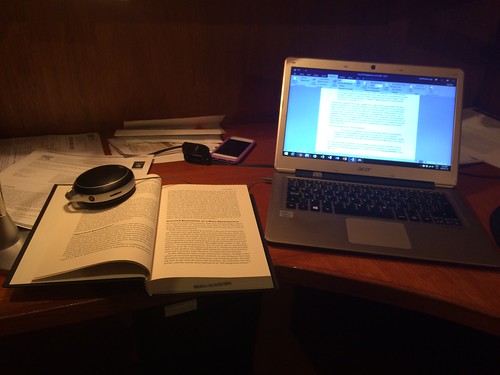They Say / I Say: The Moves That Matter In Academic Writing
When I wrote my blog post on how to properly teach our students how to do Description vs Analysis in their academic writing, I linked to a number of resources. The one that Dr. Omar Wasow (Princeton University) recommended was "They Say/I Say: The Moves that Matter in Academic Writing", edited by Gerald Graff and Cathy Birkenstein.

I do not teach argumentative writing (though CIDE, my institution, has a series of courses on this – which probably follow a different model because CIDE is a Spanish-speaking institution in a Spanish-speaking country), but I do teach courses in public policy where I need my students to conduct analyses. Since I teach all my courses in English, I needed a different model, particularly because I have noticed that sometimes students do not know how to write good analysis instead of providing very descriptive texts.
Omar's recommendation is sincerely amazing. They Say/I Say is a relatively short book of templates that dissects how academic writing should engage in dialogue. I think the book is very well summarized in the following direct quote off of the text (p. 3):
"For us, the underlying structure of effective academic writing – and of responsible public discourse – resides not just in stating our own ideas but in listening closely to others around us, summarizing their views in a way that they will recognize, and responding with our own ideas in kind"
While the book offers a number of templates, the underlying logic of They Say/I Say is to enable students (and writers) to use those templates to create their own writing structures. That means, students can practice through adapting the They Say/I Say templates to the specific contents, disciplines and materials at hand. As Graff and Birkenstein say, you need to be "putting in your oar" (getting yourself involved in the writing)

Graff and Birkenstein author a large portion of the book, though a couple of chapters are invited. The first part of the book introduces models and templates to present others' views and introduce what They Say. I'm not particularly fond of a few of the models they use to introduce 'Standard Views" ("many people argue", "since the dawn of time", etc.) on pages 23 and 24, but the overall gist of the book is excellent and examples provided are super helpful, not only for students but also for early career scholars.
I particularly enjoyed Chapter 2, "Her Point Is – The Art of Summarizing" (pages 30-40) because one of the skills I teach my research assistants and undergraduate/graduate students is how to write rhetorical precis and synthetic notes. This chapter provides students with templates for how to write solid summaries that then can be converted into full-fledged memorandums.
Chapter 3, "As He Himself Puts It – The Art of Quoting" (pages 42-50) should be mandatory reading for students, particularly because of all the recent cases of plagiarism in academic writing. This chapter teaches students how to properly do quotations and highlights the importance of attribution.
I also think these two chapters should be read in conjunction (if I may be so bold to suggest) with my posts on writing memorandums and the Conceptual Synthesis Excel Dump (where you would be dumping your quotations). These chapters are also very good at helping students find the specific quotations they may need (particularly when the student is pressed for time and strategically triaging his/her reading packet for relevance).
Graff and Birkenstein show (in Chapter 4, "Yes/ No/ Okay, But – Three Ways to Respond", p. 55-67) three different models of engagement with the literature (i.e. with what "They Say"): agreeing, disagreeing and somewhere in between. I tend to do a lot more contrasting in my own scholarly writing (i.e. "X argues that Z. However, I find that W"), but it's very nice and useful to read different ways of engaging others' arguments (AND the empirical evidence, which we often do not write about).

Perhaps the most important chapter for graduate students (not terribly important for undergraduates, in my view, but fundamental for Masters and PhD candidates) is Chapter 5, "And Yet – Distinguishing What YOU Say from what THEY Say, pages 68-75″. This chapter is key because the biggest challenge that graduate students tend to have in their writing (in my experience) is showcasing what THEIR own contribution is. This ability to produce text that highlights the writers' own contributions is key when teaching description versus analysis in academic writing. I am also very glad that Graff and Birkenstein emphasize the importance of writing in the first person ("I find", "I argue", "I show").
Chapter 6, which involves "inserting a naysayer into the conversation" wasn't that appealing to me, to be perfectly honest. But Chapter 7 ("So What? Who Cares? Saying Why It Matters ", p. 92-100) helps the reader explain why the analysis presented throughout the paper may be useful. I am particularly fond as well of Chapter 8 ("As A Result: Connecting The Parts", p. 105-117) because in this chapter Graff and Birkenstein demonstrate how to effectively tie an argument together by connecting all the different parts of an argument.
Graff and Birkenstein's four strategies to connect sentences may make some educators cringe, because they use some of the connectors that often appear in lists of "words that should be banned" (also known as "wordy ways of saying things that you could more easily say in this other way"). Nevertheless, in my opinion, Graff and Birkenstein's strategies are solid and I reproduce them right here (taken from page 108):
- Using transition terms.
- Adding pointing words.
- Developing a set of key terms and phrases for each text you write.
- Repeating yourself with a difference.

Chapters 13 (written by Christopher Gillen) and 15 (by Erin Ackerman) offer really excellent advice on how to use the They Say/I Say model in the natural sciences (Gillen, p. 156-174) and social sciences (Ackerman, p. 175-192). I will definitely use Chapter 14 by Erin Ackerman to teach my undergraduate and graduate students how to use the They Say/I Say model in public policy writing.
Overall, the Graff and Birkenstein "They Say/I Say" book is a fantastic introduction to how to write arguments and craft text that will be read in both natural and social sciences. Adding Gillen and Ackerman's chapters was a genius move by Graff and Birkenstein, because the examples they provide are specific to natural sciences and social sciences/humanities. The chapters I have highlighted in these reading notes could possibly be used in a short course on academic writing based on the They Say/I Say model, although an instructor may want to also add the "But Don't Get Me Wrong – The Art of Metacommentary" chapter 10, p. 129-137.
While I think Graff and Birkenstein is most suited to teaching how to do academic writing in the English language, I am sure you could adapt some of the lessons the authors present to Spanish (a language in which I will be teaching this fall). Hopefully my reading notes will be useful to educators who teach academic writing and how to write research papers.
They Say / I Say: The Moves That Matter In Academic Writing
Source: http://www.raulpacheco.org/2017/05/they-sayi-say-the-moves-that-matter-in-academic-writing-my-reading-notes/
Posted by: walkeriiii1981.blogspot.com

0 Response to "They Say / I Say: The Moves That Matter In Academic Writing"
Post a Comment